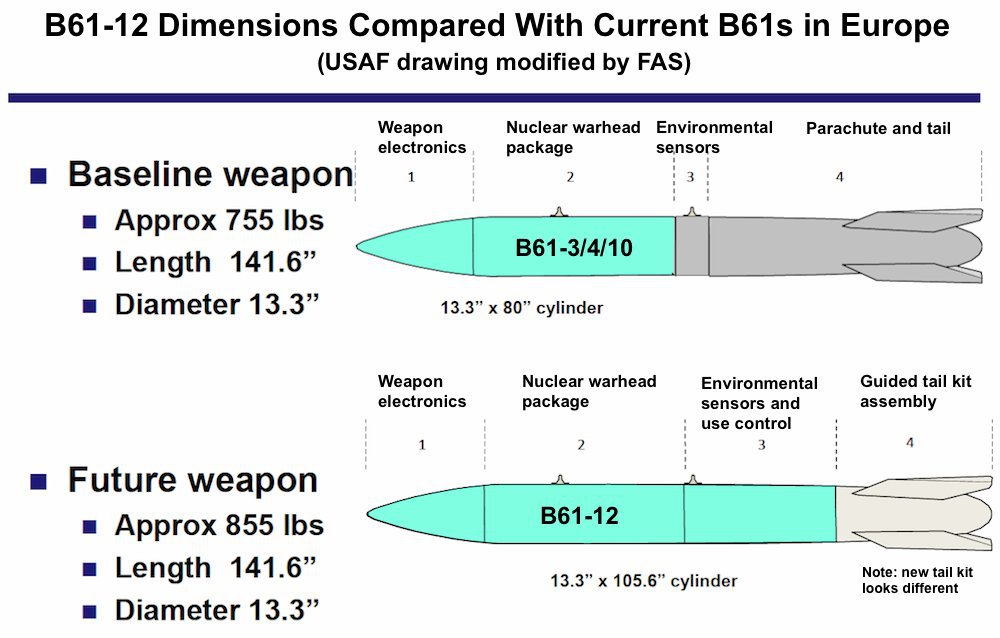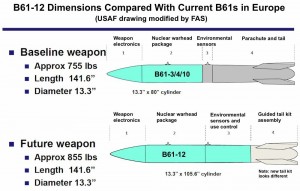



Almost simultaneously, another announcement arrived from the United States: “The U.S. Air Force and National Nuclear Security Administration (NNSA) have conducted the first flight test of the jointly developed B61-12 guided nuclear bomb from a Boeing F-15E Strike Eagle at the Tonopah Test Range in Nevada.” (flightglobal.com, July 10) This weapon will soon replace the U.S. nuclear bomb called B61, with between 70 and 90 of them stored in Aviano and Ghedi Torre, part of an arsenal of at least 200 nuclear weapons stored in Germany, Belgium, the Netherlands and Turkey.
The success of the test, “provides clear evidence of the nation’s continued commitment to maintain the B61,” says the NNSA, which then specifies that “the B61-12, with a tail kit assembly produced by Boeing, will replace the B61-3, -4, -7, -10 bombs in the current U.S. nuclear arsenal.” It is thus officially confirmed that the B61 bomb will be transformed from a free falling bomb to a “smart” bomb, which can be dropped on the target from a great distance. The precision-guided B61-12, whose cost is estimated at 8 billion to 12 billion dollars for 400 to 500 bombs, is configured as a multipurpose weapon, with an average power of 50 kilotons (about four times that of the Hiroshima bomb). It will perform the function of many bombs, including those designed to “decapitate” the enemy country, destroying the bunker command centers and other underground structures in a nuclear first strike.
The replacement of the B61 with the B61-12, announces the NNSA, “provides assurance to our allies.” This is demonstrated by the fact that at the U.S.-Italian air bases at Aviano near Venice and Ghedi near Milan, nuclear bombs are kept in special hangars with fighters ready for nuclear attack: U.S. F-15 and F-16 and Italian Tornado jets, whose pilots are trained for a nuclear attack. In Italy, in 2013 and 2014, NATO held the nuclear war exercise “Steadfast Noon,” which Polish F-16s also participated in last year.
Thus, Italy is violating the Treaty on Non-proliferation, whose Article 2 states: “Each non-NWS party undertakes not to receive, from any source, nuclear weapons, or other nuclear explosive devices; not to manufacture or acquire such weapons or devices; and not to receive any assistance in their manufacture.”
The modernization of U.S. nuclear weapons deployed in Europe is part of the growing nuclear arms race. According to the Federation of American Scientists, the U.S. maintains 1,920 strategic nuclear warheads ready to launch (out of a total of 7,300 warheads), compared to 1,600 Russian ready to launch (out of 8,000). Including French and British weapons, NATO nuclear forces have some 8,000 nuclear warheads, of which 2,370 are ready to launch. Adding those of the Chinese, Pakistani, Indian, Israeli and North Korean weapons, the total number of nuclear warheads is estimated at 16,300, of which 4,350 are ready to launch. And the nuclear arms race continues the ongoing modernization of arsenals.
For this reason, the big hand of “Apocalypse Watch,” the symbolic timepiece that the “Bulletin of the Atomic Scientists” uses to tell us how many minutes until the midnight of nuclear war, has been moved from five to midnight in 2012 to three to midnight in 2015, the same level as in 1984 in the midst of the Cold War.
The risk is particularly high that one day nuclear weapons will be used in the Middle East, where the only country to possess them is Israel, which unlike Iran has not signed the Non-Proliferation Treaty. According to estimates, the Israeli armed forces have 100 to 400 nuclear warheads, including H-bombs, with a power equivalent to almost 4,000 Hiroshima bombs. Israeli delivery systems include over 300 U.S. F-16 and F-15 fighter-bombers, also armed with U.S.-Israeli Popeye missiles with nuclear warheads, and approximately 50 Jericho II ballistic missiles on mobile launching ramps. Israel also has four Dolphin submarines, modified for nuclear attack, provided by Germany, which last September delivered the fourth of the six planned.
In addition, the United States has signed agreements to supply, to Saudi Arabia, Bahrain and the United Arab Emirates, nuclear technology and fissile material with which they can acquire nuclear weapons. Saudi Arabia has officially declared there is nothing to prevent them from building or acquiring nuclear weapons with the help of Pakistan, whose nuclear weapons program they fund to the tune of 60 percent. (The Independent, March 30)
On this background, the Vienna negotiation appears as a tragic melodrama. It put the spotlight on Iran, which does not possess nuclear weapons and whose civilian nuclear program is verifiable, but it leaves aside the dramatic reality of the nuclear arms race. This was done to convince the public that, with the Iranian nuclear agreement, “Our world is safer.”
Manifesto, July 15, 2015
The author published this article in Italian in the July 15 issue of Il Manifesto. WW publishes a translation by WW managing editor John Catalinotto.
This statement was recently issued by over 30 groups. On Friday, March 28, Dr. Helyeh…
When Donald Trump announced massive tariffs on foreign imports April 2, Wall Street investors saw…
The century-long struggle to abolish the death penalty in the U.S. has been making significant…
Download the PDF May Day appeal to the working class Revolutionary change is urgent! Gaza…
Philadelphia On March 26, the Pennsylvania Supreme Court denied political prisoner Mumia Abu-Jamal permission to…
There are two important and overlapping holidays on April 22: Earth Day and Vladimir Lenin’s…